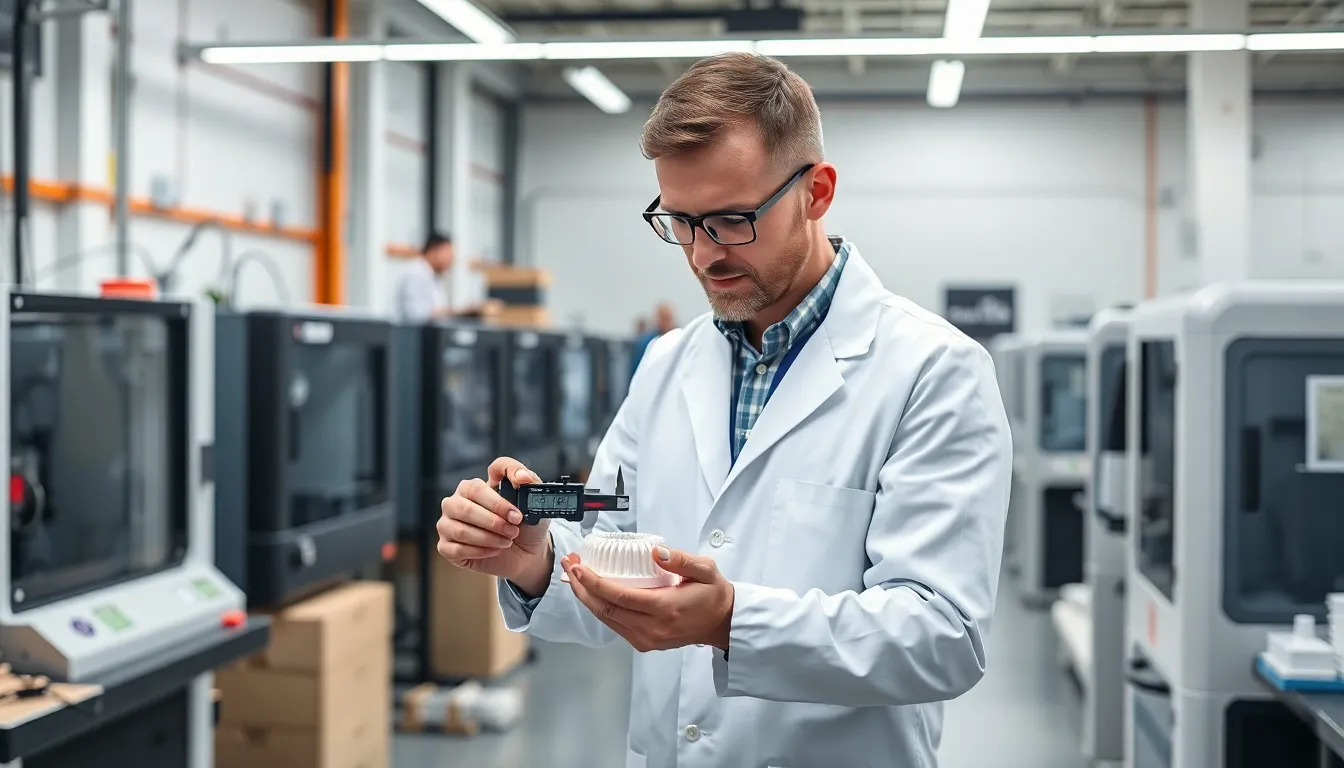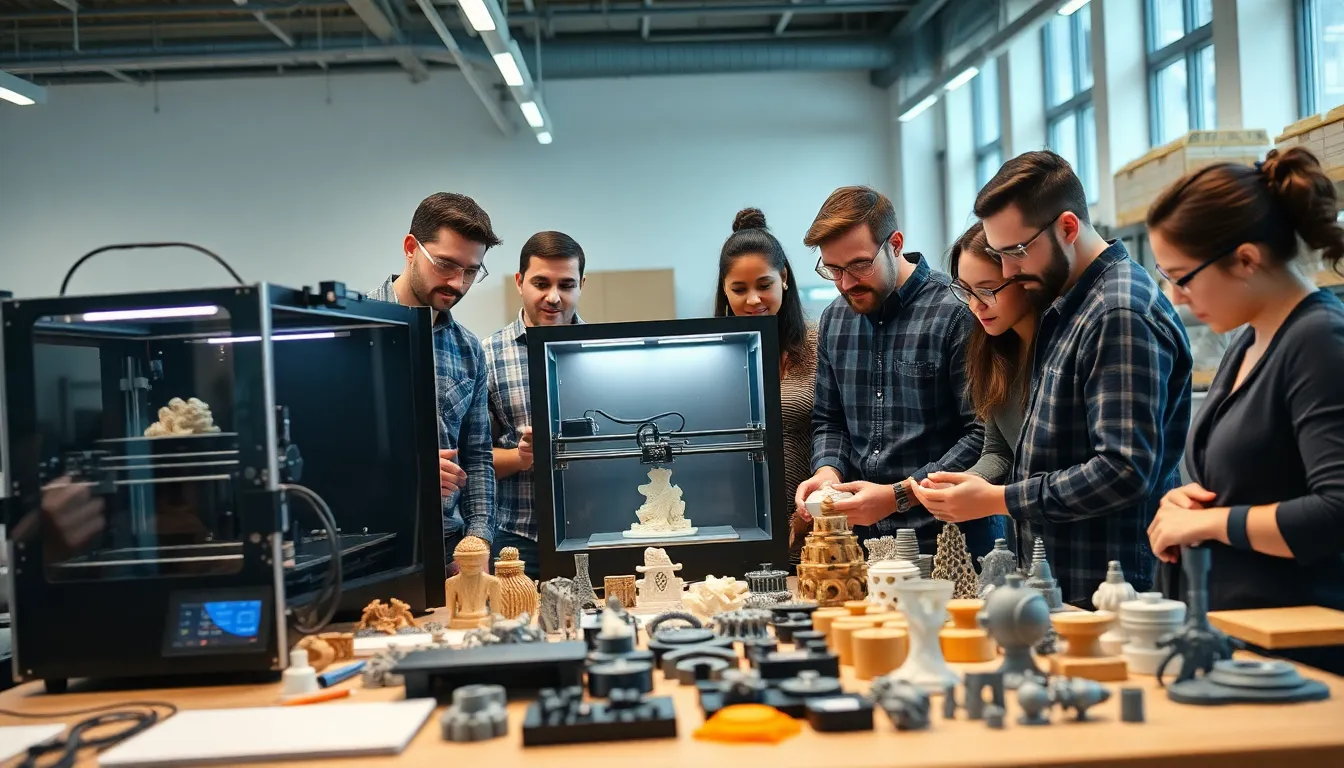In today’s fast-paced world, 3D manufacturing solutions are revolutionizing the way industries create and innovate. This technology offers unprecedented flexibility and efficiency, allowing businesses to produce complex designs that were once unimaginable. From aerospace to healthcare, 3D printing is not just a trend; it’s a game-changer that’s reshaping production processes.
As companies strive for sustainability and cost-effectiveness, 3D manufacturing stands out by minimizing waste and reducing lead times. With advancements in materials and techniques, the potential for customization and rapid prototyping has never been greater. Understanding these solutions can empower businesses to stay competitive in an ever-evolving market.
Table of Contents
ToggleOverview of 3D Manufacturing Solutions
3D manufacturing solutions leverage additive manufacturing technologies to produce parts and products layer by layer. This process allows for intricate designs that traditional methods find challenging or impossible. Industries such as aerospace, automotive, healthcare, and consumer goods benefit from the customization and complexity offered by 3D printing.
3D printing improves efficiency by reducing production waste through precise material usage. Techniques such as fused deposition modeling (FDM) and selective laser sintering (SLS) showcase the versatility of materials, enabling manufacturers to choose from polymers, metals, and ceramics according to project needs.
3D manufacturing supports rapid prototyping, cutting down development timelines significantly. Organizations can test and iterate designs swiftly, which enhances innovation. Companies relying on these solutions maintain competitiveness by responding quickly to market demands, demonstrating adaptability in a fast-paced environment.
3D manufacturing solutions align with sustainability goals. The reduction of excess material not only minimizes waste but also lowers transportation costs due to localized production capabilities. This approach promotes environmentally conscious practices in manufacturing, appealing to consumers increasingly seeking sustainable options.
3D technology adoption continues to grow, driven by ongoing advancements in software and materials. As more businesses recognize its advantages, the future of manufacturing is poised for further transformation.
Types of 3D Manufacturing Solutions

3D manufacturing solutions encompass various methods, each with unique processes and applications. Understanding these types helps industries select the most suitable approach for their needs.
Additive Manufacturing
Additive manufacturing constructs parts layer by layer, utilizing materials such as plastics, metals, and ceramics. Techniques like Fused Deposition Modeling (FDM) and Selective Laser Sintering (SLS) allow for complex geometries that traditional subtractive methods can’t achieve. This method enhances design flexibility and enables customization, making it ideal for industries like aerospace and healthcare, where precision and adaptability are crucial. Additive manufacturing also minimizes waste by using only the necessary material for each layer.
Subtractive Manufacturing
Subtractive manufacturing involves removing material from a solid block through processes like machining, milling, and laser cutting. This method can produce high-precision components but often generates significant waste. While it’s common in automotive and industrial applications, it lacks the design freedom that additive manufacturing offers. Subtractive techniques excel in creating components requiring stringent tolerances; however, they involve longer lead times compared to additive processes.
Hybrid Manufacturing
Hybrid manufacturing combines both additive and subtractive techniques to leverage the benefits of each. This approach allows for the creation of parts with complex geometries through additive methods, followed by finishing processes from subtractive manufacturing for enhanced precision. Hybrid solutions optimize production efficiency, reduce material waste, and improve overall part quality. Industries such as aerospace and defense are increasingly adopting hybrid manufacturing for producing critical components that demand both complexity and accuracy.
Benefits of 3D Manufacturing Solutions
3D manufacturing solutions offer numerous advantages, making them essential in modern production environments. Key benefits include cost efficiency, design flexibility, and speed of production.
Cost Efficiency
Cost efficiency arises from reduced material waste and lower labor costs. Companies utilize precise material application in 3D printing, resulting in savings of up to 50% compared to traditional manufacturing methods. Additionally, shorter production runs decrease expenses related to inventory and storage. According to a study by Wohlers Associates, companies report up to 90% reduction in prototyping costs, enabling more effective resource allocation.
Design Flexibility
Design flexibility significantly enhances creative possibilities with 3D manufacturing. Engineers can create complex geometries and intricate details that traditional manufacturing methods cannot achieve. This flexibility supports custom designs tailored to specific applications. A report by McKinsey highlights that 3D printing accommodates numerous iterations without extensive retooling, enabling businesses to adapt swiftly to market changes. This capability positions firms to meet evolving consumer demands effectively.
Speed of Production
Speed of production is a critical advantage. 3D printing technology significantly reduces lead times for prototypes and finished products. Organizations can produce parts in days instead of weeks, accelerating the time-to-market. For example, firms using additive manufacturing can shift from concept to production in as little as 24 hours, drastically improving competitive positioning. Faster production also allows for quicker iterations, enhancing innovation and responsiveness in dynamic industries.
Applications of 3D Manufacturing Solutions
3D manufacturing solutions find extensive applications across multiple industries, driving innovation and efficiency. This technology enables businesses to adapt quickly to market demands and enhance their product offerings.
Aerospace Industry
3D manufacturing solutions transform the aerospace sector by enabling the production of lightweight components that improve fuel efficiency. It allows for the rapid creation of custom parts, which reduces lead times for prototypes and replacements. For example, companies can produce intricate brackets and connectors that traditional methods cannot accomplish. The reduced weight from 3D-printed components not only saves fuel but also enhances aircraft performance. With advancements in materials, such as titanium alloys, parts exhibit superior strength and resistance to corrosion.
Automotive Industry
In the automotive industry, 3D manufacturing solutions streamline production processes and optimize inventory management. Manufacturers utilize this technology for rapid prototyping, enabling quick design iterations. Custom tooling, for instance, can be manufactured faster and at lower costs, enhancing overall production efficiency. 3D printing facilitates the creation of complex internal geometries for components like intake manifolds, leading to improved engine performance. Many companies report shortened development cycles, allowing them to respond to market trends more effectively.
Medical Sector
3D manufacturing solutions revolutionize the medical sector by allowing the fabrication of personalized medical devices and implants. Custom-fit prosthetics and dental implants can be produced efficiently, enhancing patient outcomes. For instance, 3D printing enables the creation of patient-specific surgical guides that improve the precision of complex procedures. Additionally, bioprinting technologies are emerging, offering the potential to print human tissues for regenerative medicine. This innovation reduces costs and enhances the effectiveness of treatment options, making healthcare more patient-centered and effective.
Challenges in 3D Manufacturing Solutions
3D manufacturing solutions face several challenges that can impede their widespread adoption. Addressing these challenges is essential for maximizing the effectiveness of this technology across industries.
Material Limitations
Material limitations significantly impact 3D manufacturing capabilities. Common materials like plastics, metals, and ceramics are used, but each has specific properties that can restrict applications. Certain industries, such as aerospace and healthcare, require high-performance materials that can withstand extreme conditions. These specialized materials may not yet be compatible with all 3D printing methods, limiting production possibilities. Additionally, factors like strength, temperature resistance, and biocompatibility must align with the intended use, which often necessitates ongoing research and development.
Technical Expertise Required
Technical expertise presents a notable barrier for companies adopting 3D manufacturing solutions. Designing parts for 3D printing requires knowledge of CAD software and an understanding of additive manufacturing techniques. Skilled professionals are essential for optimizing designs for printability and performance. At the same time, organizations may struggle to find qualified personnel, resulting in a skills gap that hinders implementation. Continuous training programs and investment in workforce development can help bridge this gap, but many businesses face resource constraints.
Regulatory Concerns
Regulatory concerns significantly affect the adoption of 3D manufacturing solutions across various sectors. Compliance with industry standards and regulations is critical, particularly in aerospace, automotive, and medical industries, where safety and reliability are paramount. Regulatory bodies often lack comprehensive guidelines specific to 3D printed products, leading to uncertainty in the approval process. Companies must navigate these complex regulatory landscapes, which can delay product development and market entry. Ongoing dialogue between industry stakeholders and regulators is crucial for establishing frameworks that support innovation while ensuring safety and compliance.
The rise of 3D manufacturing solutions is reshaping industries by fostering innovation and efficiency. As businesses embrace this technology they unlock new levels of customization and sustainability. The ability to produce complex designs quickly and with minimal waste positions 3D printing as a game-changer in today’s competitive landscape.
Despite the challenges related to materials and technical expertise ongoing advancements promise to enhance the capabilities of 3D manufacturing. With continued collaboration among industry stakeholders the future looks bright for this transformative technology. Organizations that leverage these solutions will likely gain a significant edge in their respective markets.





